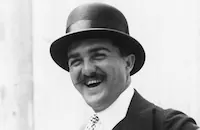Jane Eyre
Brief Synopsis
Cast & Crew
Christy Cabanne
Virginia Bruce
Colin Clive
Beryl Mercer
David Torrence
Aileen Pringle
Film Details
Technical Specs

Synopsis
In England of the mid-eighteenth century, young Jane Eyre is forced to defend herself against the cruel pranks of her foster parents' children, John and Georgiana Reed, and consequently is sent to an orphanage. There, Jane is befriended by Miss Temple, an instructor, but suffers from the stern treatment of Mr. Brocklehurst, the headmaster. After years of loneliness and hardship, Jane earns a position as an instructor at the orphanage. Brocklehurst's continued cruelty, however, finally drives Jane to accept a job as governess to the daughter of Edward Rochester, a wealthy English gentleman. Jane soon ingratiates herself with Edward and his niece Adele, as well as with Sam Poole, the coachman, and housekeeper Mrs. Fairfax. Jane's newfound happiness, however, is disturbed by the unexplained screams that she hears during the night and by the fact that Edward has prohibited her from entering a certain wing of the house. Unknown to Jane, the screams are those of Bertha, Edward's insane wife, who has been cloistered in the forbidden wing for years. While lawyer Charles Craig works quietly to get Edward a divorce, Edward plans a lavish ball to which he invites his fiancée, Blanche Ingram, and her parents, Lord and Lady Ingram. After the ball, Bertha sneaks into Edward's room and sets his bed curtains on fire. Alerted by the smell of smoke, Jane rushes to put out the flames and saves Edward's life. Shortly after a two-week trip to London, Edward confesses to Jane that he loves her and convinces her to marry him. During the wedding ceremony, however, Bertha breaks out of her rooms and raves about being Edward's wife. In spite of Edward's pleas, a heartbroken Jane runs away and eventually takes a position with Dr. John Rivers, a clergyman and charity worker. Later, Bertha sets Edward's house on fire, and Edward is blinded while trying to save her life. After Edward moves into his caretaker's cottage, Jane, unaware of his plight, makes plans to marry Dr. Rivers and move to India with him. Just before she is to leave, however, Sam Poole wanders into Dr. Rivers' mission and relates Edward's sad situation. Jane returns to her blind lover and forces him to accept her love.

Director

Christy Cabanne
Cast

Virginia Bruce

Colin Clive
Beryl Mercer
David Torrence
Aileen Pringle
Edith Fellowes
John Rogers
Jean Darling
Lionel Belmore
Jameson Thomas
Ethel Griffies
Claire Du Brey
William Burress

Joan Standing

Richard Quine
Desmond Roberts
Clarissa Selwynne
Hylda Tyson
Gretta Gould
Edith Kingdon
William Wagner
Olaf Hytten
Gail Kaye
Anne Howard
Crew

Film Details
Technical Specs

Quotes
Trivia
Notes
The traditional song "Sweet and Low" is sung by Virginia Bruce in the picture. Monogram borrowed Bruce from M-G-M for this production, which was the actress' first film in two years. In 1932, Bruce married actor John Gilbert and quit acting after her performance in M-G-M's Konga (see below). In 1934, she divorced Gilbert and returned immediately to the screen. A Hollywood Reporter news item adds Doris Lloyd to the cast, but her participation in the final film has not been confirmed. Modern sources credit Abe Meyer with the film's musical direction. Modern sources also note that the film was shot in part at Sherwood Forest, CA. Many versions of Charlotte Brontë's novel have been filmed, including a 1914 Whitman Features production, starring Lisbeth Blackstone and a 1918 Select Pictures film called Woman and Wife, directed by Edward José and starring Alice Brady and Elliott Dexter (see AFI Catalog of Feature Films, 1911-20; F1.2264 and F1.5064); a 1921 Hugo Ballin production, directed by Ballin and starring Mabel Ballin (see AFI Catalog of Feature Films, 1921-30; F2.2782); the well-known 1944 Fox version, directed by Robert Stevenson and starring Joan Fontaine and Orson Welles; and a 1971 British production, directed by Delbert Mann and starring Susannah York. Ethel Griffies played "Grace Poole" in both the 1934 and 1944 versions.












